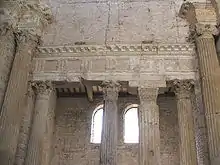Architrave
In classical architecture, an architrave (/ˈɑːrkɪtreɪv/; from Italian: architrave "chief beam", also called an epistyle;[1] from Greek ἐπίστυλον epistylon "on the column") is the lintel or beam that rests on the capitals of columns.

The term can also apply to all sides, including the vertical members, of a frame with mouldings around a door or window. The word "architrave" has come to be used to refer more generally to a style of mouldings (or other elements) framing a door, window or other rectangular opening, where the horizontal "head" casing extends across the tops of the vertical side casings where the elements join (forming a butt joint, as opposed to a miter joint).[2]
Classical architecture
In an entablature in classical architecture, it is the lowest part, below the frieze and cornice. The word is derived from the Greek and Latin words arche and trabs combined to mean "main beam". The architrave is different in the different Classical orders. In the Tuscan order, it only consists of a plain face, crowned with a fillet, and is half a module in height. In the Doric and Composite order, it has two faces, or fasciae, and three in the Ionic and Corinthian order, in which it is 10/12 of a module high, though but half a module in the rest.[3]
Metaphorical use
The term architrave has also been used in academic writing to mean the fundamental part of something (a speech, a thought or a reasoning), or the basis upon which an idea, reasoning, thought or philosophy is built.
Examples:
Indian architecture
In śilpaśāstra, the Hindu texts on architecture, the architrave is commonly referred to by its Sanskrit name uttara.[6] In Hindu temple architecture it is placed above the bracket (potika) of a pillar (stambha), which gives it extra support. The Indian entablature is called prastara.
Dravidian architecture recognizes several distinct types of architraves:[7]
- rounded (vṛttapotika)
- wavy (taraṅgapotika)
- flower shaped (puṣpapotika)
- bevel and tenon type (ādhārapotika)
- voluted (muṣṭibanda)
- figural (citrapotika)
See also
- Archivolt – expanded and elaborated architrave element
- Dolmen – Neolithic predecessor, megalithic tombs with structural stone lintels
- Lintel
- Post and lintel – architectural system with architraves-lintels
Footnotes
- Chisholm, Hugh, ed. (1911). . Encyclopædia Britannica. Vol. 9 (11th ed.). Cambridge University Press. p. 703.
- Ching, Francis D.K. (1995). A Visual Dictionary of Architecture. New York: John Wiley & Sons, Inc. pp. 179, 186. ISBN 0-471-28451-3.
-
 This article incorporates text from a publication now in the public domain: Chambers, Ephraim, ed. (1728). Cyclopædia, or an Universal Dictionary of Arts and Sciences (1st ed.). James and John Knapton, et al.
This article incorporates text from a publication now in the public domain: Chambers, Ephraim, ed. (1728). Cyclopædia, or an Universal Dictionary of Arts and Sciences (1st ed.). James and John Knapton, et al. {{cite encyclopedia}}: Missing or empty|title=(help) - Page: XIV, The Ethics of Democracy: A Contemporary Reading of Hegel's Philosophy of Right (Lucio Cortella, SUNY Press, 2015)
- Pag. 281, Economics and institutions Contributions from the History of Economic thought (Pier Francesco Asso, Luca Fiorito, Italian Association for History and Economic Thought, Vol. IV, Franco Angeli Press 2007)
- "Temples of Salem region Up to 1336 AD" (PDF).
- "Temples of Salem region Up to 1336 AD" (PDF).
External links
 Media related to Architraves at Wikimedia Commons
Media related to Architraves at Wikimedia Commons
